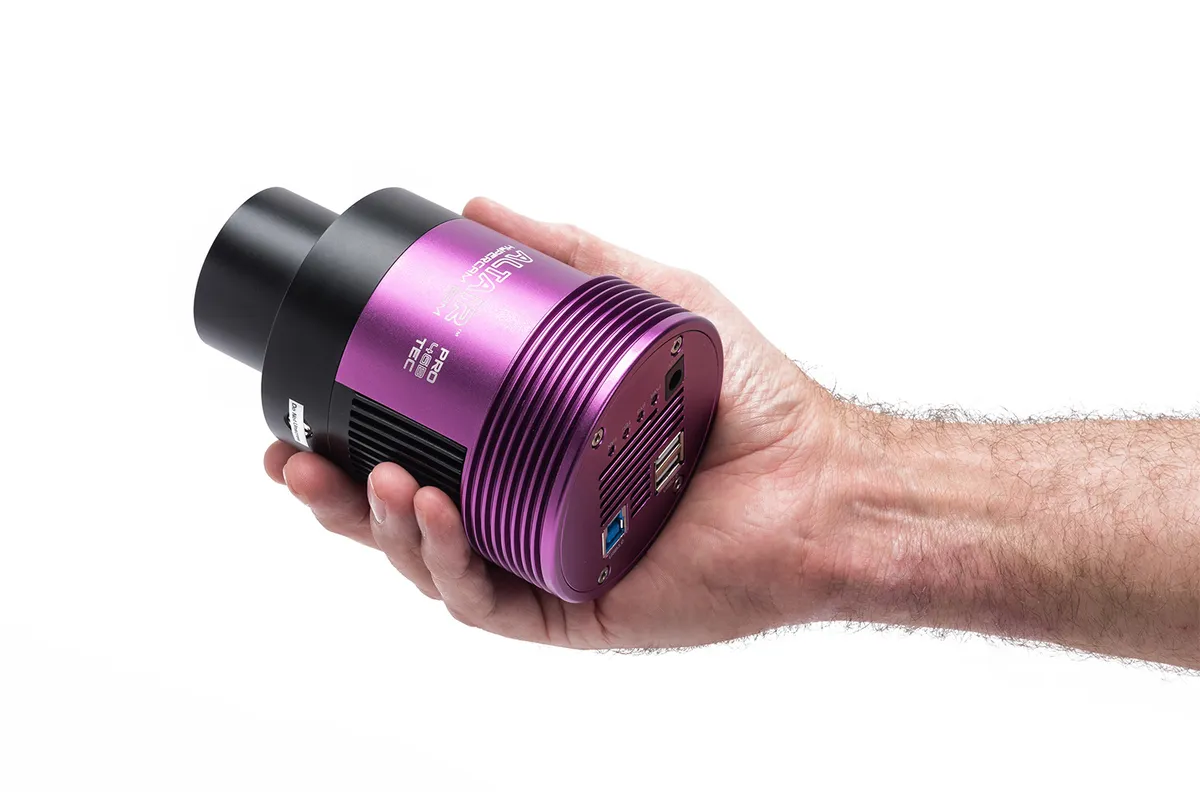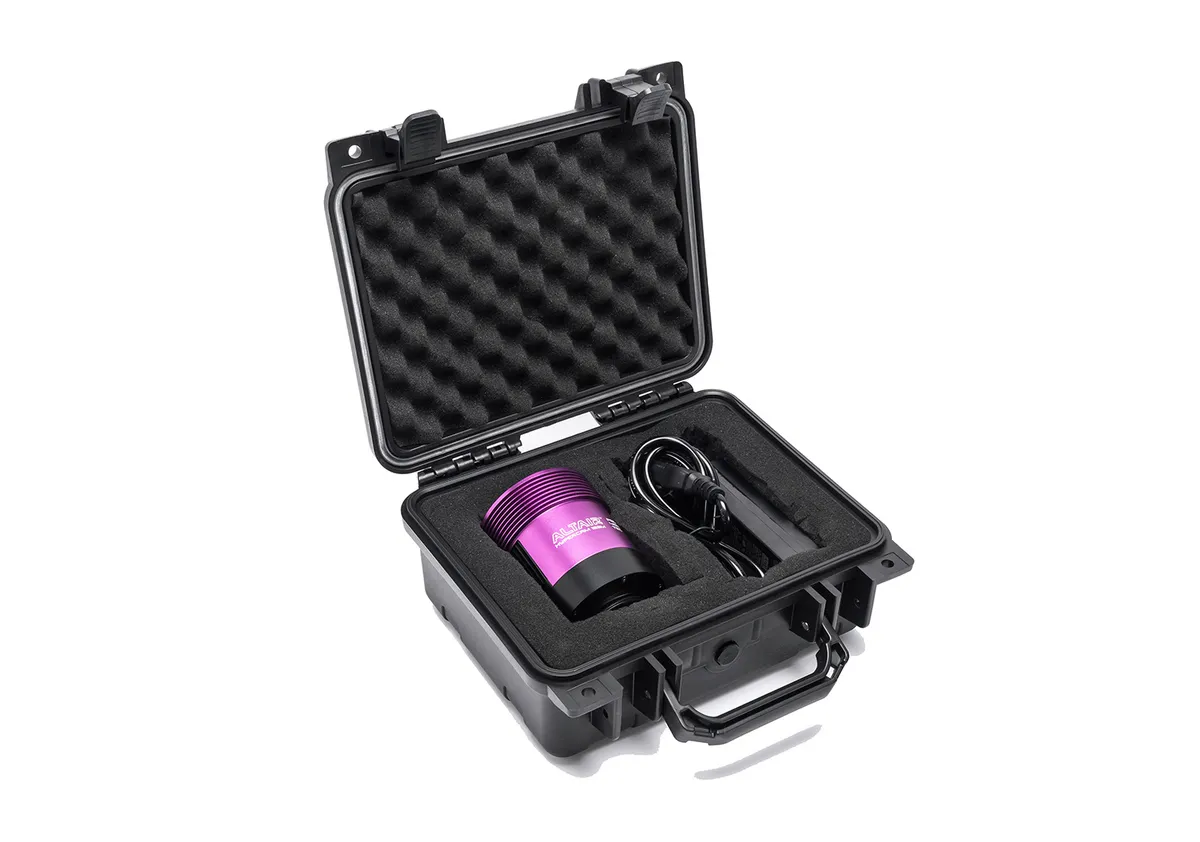Having previously reviewed Altair’s capable 183 Hypercam family, we couldn't help but wonder about the potential of these cameras with the addition of electronic cooling. With the Hypercam 183M Pro Tec 4GB we get a beefy upgrade to the standard models that, with its precise temperature control, helps to realise its full potential as a deep-sky astrophotography camera.
Software for the camera is free, but not included in the package, so we followed the link provided and installed the latest version of Altair Capture.
We used our existing USB 2.0 arrangement (forgoing the USB 3.0 port and cable provided), but the software immediately recognised this and in just a short time the camera was ready to use – ideal for amateurs (the Pro in the name relates to the performance of the Hypercam rather than the intended expertise of the user).
Powerful sensor temperature reductions, in this case down to –45°C below ambient temperature, require a dedicated power supply, and a 12V power supply unit suitable for interior use is included.

The fan and thermoelectric cooling (TEC) system only operate when the camera is connected to a computer, and the required temperature is easily set within Altair Capture.
The manufacturer website states that no practical benefit is achieved by cooling the IMX183 sensor below –15°C.
In our tests we found that going lower than –20°C pushed the limits of the inbuilt anti-dewing features, leading to an undesirable dew spot forming in the middle of the optical window.
Midsummer skies offer precious little opportunity for deep-sky imaging and although the Hypercam offers various settings for planetary or lunar images, we thought it prudent to concentrate on acquiring typical summertime deep-sky images, relying on narrowband filters to make up for the lack of astronomical darkness.
Short focal length refractors would make an ideal match for this camera, but to increase contrast in poor skies we opted for a6-inch, 1,050mm telescope as a companion.
Turning first to the Dumbbell Nebula, M27, we ran a series of 10-minute exposures, with a gain setting of 1.
The results were very impressive, even from a single exposure. Unwanted image artefacts that were quite evident in the standard Hypercam variants were pretty much eradicated.
As anticipated, a bright, ‘star burst’ artefact is produced on the right-hand side of the image as a result of the CMOS chip hardware, but this is effectively nullified by taking matching dark frames at the same temperature and same duration as the light frames.

We were really impressed with the camera’s ability to pick up even the faintest outer reaches of the Dumbbell Nebula in just 10-minute exposures.
However, this limited us to just a handful of useful exposures per session, so we cut the exposure time to five minutes and increased the gain setting to compensate, meaning we could double the amount of pictures acquired.
Being able to easily manipulate the camera settings to suit the available conditions in this way enabled us to make the most of the limited sessions we had.
We could easily take matching dark images, even during daytime, and felt that the Hypercam 183M Pro Tec is an ideal camera for getting the best out of variable sky conditions.
We couldn’t resist some pictures of a frame-filling Moon, and even pointed the camera towards low-lying Jupiter. To get the best results from these targets, a fast frame rate is preferred.
On our i7 8GB laptop, the highest frame rate we could achieve in USB 3.0 mode was 35.5fps, using a region of interest (or ROI) of 1280x720 in 8-bit mode.

The USB 2.0 connection was considerably slower, but frame rates vary widely depending on individual computers.
With temperature-controlled imaging, the Hypercam 183M Pro Tec is a reasonably priced and highly capable astronomy camera, with excellent deep-sky astrophotography results.
Superior sensor
The camera’s Sony IMX183 CMOS sensor offers 20MP images, with a 5440x3648 array of 2.4x2.4 micron pixels.
Although seemingly impossibly tiny, these pixels benefit from technology known as Back Side Illumination (BSI), increasing their sensitivity and effectiveness.
The sensor QE, or quantum efficiency, is given as a healthy 84 per cent, which essentially means that 84 per cent of the light photons that hit the sensor are converted into the electronic signal that becomes our image.
In actual use, we were impressed with the camera capturing very faint narrowband light in both hydrogen alpha and oxygen (OIII) wavelengths, in exposures that are relatively short compared to CCD-based cameras.
As the IMX183 sensor is just 16mm across the diagonal, smaller, less expensive 1.25-inch filters can be used – and indeed to take colour pictures with this mono version of the Hypercam, a LRGB filter set is required, while the addition of narrowband filters will maximise the amount of nights that are useable for astro imaging.
Capture software
Altair Capture is included via download, offering full control of all the camera’s functions and providing simple image- or video-capturing ability. Lucky imaging or Electronically Assisted Astronomy options are available, working well with sensitive cameras like the Hypercam 183M.
Build and design
It’s a chunky 580g, but the Hypercam 183M is well-balanced and nicely finished, offering solid cable connections and smooth surfaces. The internal fan is quiet and a bank of LEDs highlight the camera’s working functions.
Heated optical window
Sudden drops in temperature can lead to dew spots or even ice forming on surfaces within electronically-cooled cameras. The optical window in the Hypercam 183M is heated to avoid this. Replaceable desiccant (drying agent) in a separate chamber offers further protection.
USB connectivity
The Hypercam 183M is operated through a 1.5m USB 3.0 cable, but it’s fully compatible with USB 2.0 too. On the camera’s rear, a powered USB 2.0 hub with two slots allows for a guide camera or filter wheel to be connected.
Armoured plastic case
The camera comes with a lockable and waterproof plastic case. Sturdy and foam-lined, it has cut-outs to locate the camera, cables, 12V power supply unit and accompanying accessories.
Vital stats
- Price £975
- Sensor Sony Exmor R BSI IMX183
- Sensor size 5440x3648 pixels
- Built-in memory 4GB
- Bit depth 8-bit, 12-bit or 16-bit stretched
- Size 104mmx85mm diameter
- Weight 0.58kg
- Supplier Altair Astro
- Tel 01263 731505
- www.altairastro.com
